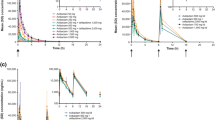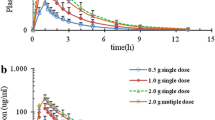Summary
Pharmacokinetic parameters and killing rates in serum of volunteers receiving amoxicillin, cefadroxil or cefixime alone or associated with niflumic acid or paracetamol were studied. Niflumic acid (250 mg) or analgesic and antipyretic drugs such as paracetamol (500 mg) are often combined with antibiotics to avoid inflammation and pain in acute ear, nose and throat diseases. Pharmacokinetic interactions between these two classes of drugs have been described in experimental models, and exceptionally in humans. The aim of the present investigation was to study the interactions of these two drugs with three antibiotics (amoxicillin 500 mg×2, cefadroxil 500 mg×2, cefixime 200 mg and one placebo capsule) on pharmacodynamic parameters and on rate of killing in the serum of six healthy volunteers receiving the antibiotic associated or not with the product in a randomized cross-over double-blind trial. The bacteria most often involved in sinusitis, bronchitis and otitis media (Haemophilus influenzae, Streptococcus pneumoniae, Staphylococcus aureus) three target diseases for oral cephalosporins and amoxicillin, were chosen for bacteriological study. Blood samples were obtained at 0.25, 0.50, 1, 1.5, 2, 4, 6 and 12 after oral administration of antibiotics alone or associated with the drugs. There was a wash-out period of at least 1 week between the eleven sequences. Antibiotics were measured by two methods: bioassay and high performance liquid chromatography (HPLC). All serum samples obtained at peak level, 4 and 6 h were tested for killing rate. Area under the time kill curve was calculated by the trapezoidal rule method and relative bioactivity in percent was defined as follows: (AUC control — AUC test)/AUC control × 100. No pharmacokinetic interaction was found in the AUC and T1/2 of the plasma concentrations of the antibiotics or associated with the drugs, regardless of dose, as determined by HPLC or microbiological assay. For these β-lactam antibiotics killing rate was found to be time-dependent. Bactericidal activity was improved onH. influenzae when cefixime was associated with niflumic acid and became concentration-dependent. A significant concentration relation was also found with niflumic acid or paracetamol associated with cefixime onStrep. pneumoniae.
Similar content being viewed by others
References
Manach Y., Ditisheim A. (1990): Double-blind, placebo-controlled multicentre trial of the efficacy and tolerance of morniflumate suppositories in the treatment of tonsillitis in children. J. Int. Med. Res., 18, 30–36.
Bobin S., Ditisheim A., Le Pajolec C., Harboun E., David N. (1989): A double-blind placebo-controlled trial of niflumic acid in the treatment of acute sinusitis. Curr. Ther. Res., 46, 1119–1128.
Carbon C. (1990): Antibiotiques et anti-inflammatoires. Pathol. Biol., 38, 255–260.
Dellamonica P., Garraffo R., Carsenti-Etesse H., Bernard E., Mondain V. (1993): Pharmacokinetic and bacteriological study of cefadroxil-salicylate and josamycin-salicylate drug regimens. Int. J. Clin. Pharmacol. Res., 13, 11–19.
Jehl F., Gallion C., Monteil H. (1990): High performance liquid chromatography of antibiotics. J. Chromatogr., 531, 509–548.
Duverne C., Bouten A., Deslandes J.F. et al. (1992): Modification of cefixime bioavailability by nifedipine in humans: involvement of the dipeptide carrier system. Antimicrob. Agents Chemother., 36, 2462–2467.
Joly V., Pangon B., Brion N., Vallois J.M., Carbon C. (1988): Enhancement of the therapeutic effect of cephalosporins in experimental endocarditis by altering their pharmacokinetics with diclofenac. J. Pharmacol. Exp. Ther., 246, 695–700.
Sordelli D.O., Cerquetti M.C., Fontan P.A., Meiss R.P. (1989): Piroxicam treatment protects mice from lethal pulmonary challenge withPseudomonas aeruginosa. J. Infect. Dis., 155, 232–236.
Tuomanen E., Hengstler B., Rich R., Bray M.A., Zak O., Tomasz A. (1987): Nonsteroidal anti-inflammatory agents in the therapy for experimental pneumococcal meningitis. J. Infect. Dis., 155, 985–989.
Khurana C.M., Deddish P.A. (1986): Treatment of osteomyelitis caused by oxacillin tolerantStaphylococcus aureus in rabbits. In: Proceedings of the 26th Interscience Conference of Antimicrobial Agents Chemotherapy, Abstract 544.
Rosner J.L. (1985): Noninheritable resistance to chlor-amphenicol and the other antibiotics induced by salicylates and other chemotactic repellents inEscherichia coli K-12. Proc. Natl. Acad. Sci. USA, 82, 8771–8774.
Domenico P., Leary R.O., Cunha B.A. (1992): Differential effects of bismuth and salicylate salts on the antibiotic susceptibility ofPseudomonas aeruginosa. Eur. J. Clin. Microbiol. Infect. Dis., 11, 170–175.
Aumercier M., Murray D.M., Rosner J.L. (1990): Potentiation of susceptibility to aminoglycosides by salicylate inEscherichia coli. Antimicrob. Agents Chemother., 34, 786–791.
Rosner J.L., Chai T.J., Foulds J. (1991): Regulation ofompF porin expression by salicylate inEscherichia coli. J. Bacteriol., 173, 5631–5638.
Burns J.L., Clark K. (1992): Salicylate-inducible antibiotic resistance inPseudomonas cepacia associated with absence of a pore-forming outer membrane protein. Antimicrob. Agents Chemother., 36, 2280–2285.
Sumita Y., Fukasawa M. (1993): Transient carbapenem resistance induced by salicylate inPseudomonas aeruginosa associated with suppression of outer membrane protein D2 synthesis. Antimicrob. Agents Chemother., 37, 2743–2746.
Author information
Authors and Affiliations
Rights and permissions
About this article
Cite this article
Carsenti-Etesse, H., Farinotti, R., Durant, J. et al. Pharmacokinetic parameters and killing rates in serum of volunteers receiving amoxicillin, cefadroxil or cefixime alone or associated with niflumic acid or paracetamol. Eur. J. Drug Metab. Pharmacokinet. 23, 357–366 (1998). https://doi.org/10.1007/BF03192294
Received:
Issue Date:
DOI: https://doi.org/10.1007/BF03192294




